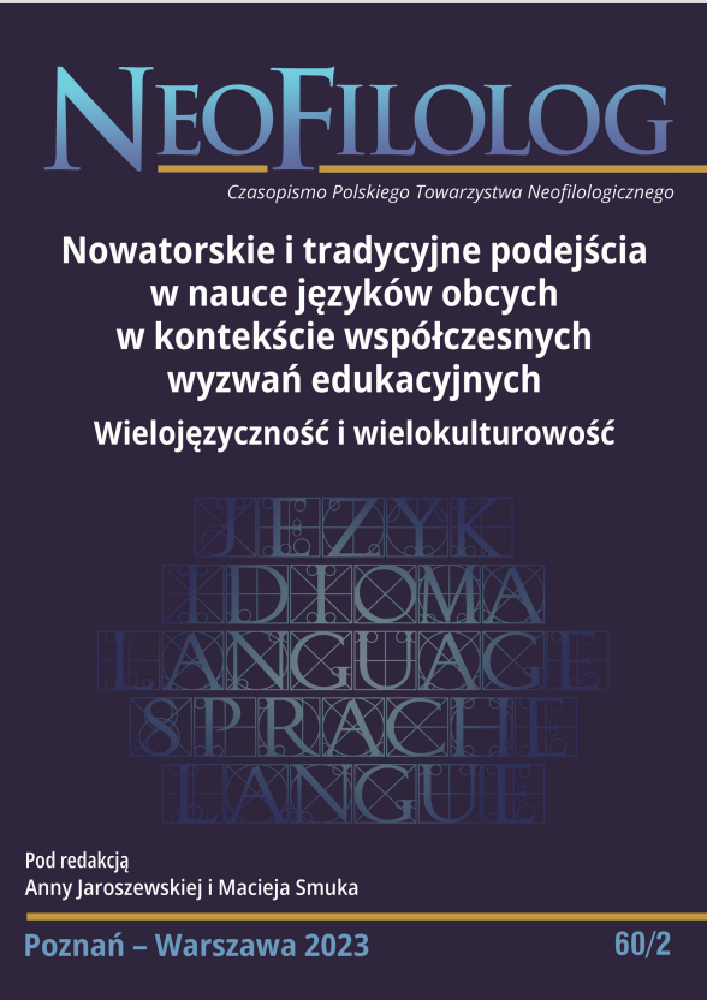Abstract
The Council of Europe has been promoting pluralistic approaches for more than 20 years, considering them as an effective tool for the development of plurilingual competence, indispensable in the multilingual Europe. The aim of the article is to determine the place of pluralistic approaches in the latest French textbooks (published after 2018) for high schools. The analysis shows that elements characteristic of pluralistic approaches are present in the analysed textbooks in varying degrees, both at the textual and paratextual level. Textbook authors use pluralistic approaches in a variety of ways, for example by referencing the knowledge of Polish, English as well as the non-verbal language.
References
Candelier M. (2008), Approches plurielles, didactiques du plurilinguisme : le même et l’autre. « Recherches en didactique des langues et des cultures – Les Cahiers de l’Acedle », no 5(1), p. 64–90. DOI: https://doi.org/10.4000/rdlc.6289
Candelier M. et al. (2012), Le CARAP. Un Cadre de Référence pour les Approches Plurielles des Langues et des Cultures – Compétences et ressources. Graz : Éditions du Conseil de l’Europe.
Castellotti V. (2001), La langue maternelle en classe de langue étrangère. Paris : Clé international.
Chmiel-Bożek H. (2021), La traduction dans les méthodes de français au niveau secondaire en Pologne : état actuel et perspectives. « Bulletin suisse de linguistique appliquée », n° 114, p. 89–111.
Conseil de l’Europe (2001), Cadre européen commun de référence pour les langues : apprendre, enseigner, évaluer. Paris : Éditions Didier.
Conseil de l’Europe (2021), Cadre européen commun de référence pour les langues : apprendre, enseigner, évaluer – Volume complémentaire. Strasbourg : Éditions du Conseil de l’Europe.
Cordier-Gauthier C. (2002), Les éléments constitutifs du discours du manuel. « Éla. Études de linguistique appliquée », n° 1(125), p. 25–36. DOI: https://doi.org/10.3917/ela.125.0025
De Carlo M. (2015), Le développement de compétences métalinguistiques par les approches plurielles, (in :) Spiță D., Lupu M., Nica D., Nica I. (dir.), Les approches plurielles dans l’éducation aux langues : l’intercompréhension, en présence et en ligne. Iasi : Editura Universitatii, p. 93–106.
Dumitrescu O. (2019), Le manuel de langue étrangère, toujours actuel, (in :) Condei C., Mogonea F., Popescu A. (dir.), Le manuel de langue étrangère. Outil de son époque, révélateur de tensions, objet d’étude, discours polyphonique. Paris : L’Harmattan, p. 230–241.
Jaskuła M. (2015), Wielojęzyczność w szkole. « Języki obce w szkole », n° 2, p. 42–46.
Komorowska H. (1999), Metodyka nauczania języków obcych. Warszawa : WSiP.
Kucharczyk R. (2018), Nauczanie języków obcych a dydaktyka wielojęzyczności (na przykładzie francuskiego jako drugiego języka obcego). Lublin : Werset.
Kusiak-Pisowacka M. (2015), Ewaluacja podręcznika w nauczaniu języków obcych. « Lingwistyka stosowana », no 14, p. 65–75.
Schröder-Sura A., Melo-Pfeifer S. (2017), L’intégration des Approches Plurielles dans les manuels de langues étrangères en Allemagne : tendances et défis, (in :) Tremblay Ch., Clairis Ch., Beacco J. C. (dir.), Plurilinguisme et éducation. Volume 2. Vincennes : Observatoire européen du plurilinguisme, p. 89–104.
Widła H. (2018), Le français : troisième langue parlée, troisième langue apprise, (in :) Piotrowska-Skrzypek M., Deckert M., Maslowski N. (dir.), Formation et compétences plurilingues. Lublin : Werset, p. 53–70.
Wilczyńska W., Michońska-Stadnik A. (2010), Metodologia badań w glottodydaktyce. Wprowadzenie. Kraków : Avalon.
License
Copyright (c) 2023 Halina Chmiel-Bożek

This work is licensed under a Creative Commons Attribution-NoDerivatives 4.0 International License.
Authors
Authors of texts accepted for publication in Neofilolog are required to complete, sign and return to the Editorial team’s office the Agreement for granting a royalty-free license to works with a commitment to grant a CC sub-license.
Under the agreement, the authors of the texts published in Neofilolog grant Adam Mickiewicz University in Poznań a non-exclusive, royalty-free license and authorize the use of Attribution-NoDerivatives 4.0 International (CC BY-ND 4.0) Creative Commons sub-license.
The authors retain the right to the free disposal of the work.
Users
Interested Internet users are entitled to use works that have been published in Neofilolog since 2017, under the following conditions:
▪ attribution – obligation to provide, together with the distributed work, information about the authorship, title, source (link to the original work, DOI) and the license itself.
▪ no derivatives – the work must be preserved in its original form. Without the author's consent, it is not possible to distribute the modified work in the form of translations, publications, etc.
Copyrights are reserved for all texts published since 2017.
Miscellaneous
Adam Mickiewicz University in Poznań retains the property right as a whole (layout, graphic form, title, cover design, logo etc.).

